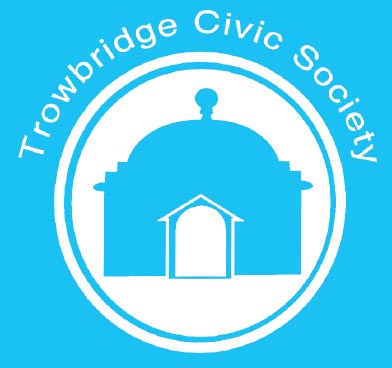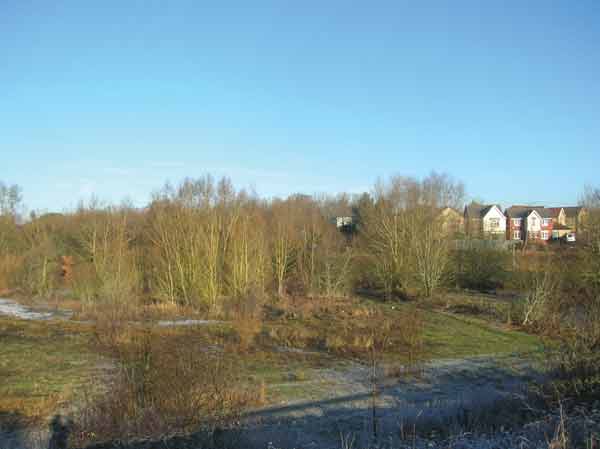| ||||||||||||||||||||||||||
Contents
Click on the item to go to the article. |
Editorial CommentFrom time to time we need to remind ourselves of our raison d'être. The aim of the Society is to improve the appearance of the area by preserving what is good from the past and encouraging high standard of design in new buildings, enhancing the image of Trowbridge and its adjacent villages and increasing the number of amenities.
Deadline for copy for the next edition is Monday, 2nd May. Letters/comments welcome. |
Forthcoming Events
| 2011 | ||
| Date and Time | Event | Venue or Meeting Point |
| Tuesday 15th March 19:15 |
Annual General Meeting followed by a talk – Studley Green
Project and Going To Blazes (Part 2) by Mr. John Craig QFSM |
Haden Room, United Church, Church Street, Trowbridge. |
| Tuesday 3rd May 14:15 |
Guided wildlife walk at Southwick Country Park. Led by John Austin | Meet in car park. |
| Friday 3rd June 19:00 |
A guided walk around Upton Scudamore with Ken Rogers (Joint event with the Friends of Trowbridge Museum. | Meet at the Upton Scudamore Parish Church. |
| Saturday 2nd July 14:30 to 16:00 |
Cream Tea and Bring & Buy. By kind invitation of Dr & Mrs Eames | 30 Hilperton Road |
| Wednesday 3rd August Leaving Trowbridge about 08:30 |
Coach trip to Poundbury and Dorchester | Click here for details |
To arrange for a lift or to volunteer to car share please contact Glyn on 755784
FROM A VICE PRESIDENT
As one of the founder members of the Civic Society I am delighted to see that it continues to grow from strength to strength. It is so important that a watchful eye is kept on the development of the town by the people who really care and want to protect its future. Trowbridge has been involved in a great part of my life. It is a town I am very proud of and fondly call it ‘my town’. I was in fact born in Keevil, but was brought into Trowbridge to school daily from the age of six. I attended Hilperton Road School, which was over a shop and run by Miss Lansdown. I had many happy hours there and then moved on to The Girls'# High School.
On leaving school I kept to Trowbridge to earn my living. I joined my former school to help with the younger children. When the then head retired I managed to acquire it. By this time it had been renamed Roundstone Preparatory School. In the next few years the school grew and had to move to larger premises so I bought 13 The Halve. However after a few years I was informed that it was to be demolished as it was in the way of the new ring road! This house is still standing as the road was not widened on that side. Now search again; this time luck was with me and I managed to acquire the lovely Courtfield House in Polebarn Road. I moved in after a battle with planning permission in 1970. What a lovely house to own and I have spent many happy hours working in the house and the two acres of garden with my late husband Bernard. I have kept as many of its original features as possible and visitors often quote to me ‘this reminds me of Harry Potter’! The building which adjoins the house, The Old Wool Store, now also belongs to me and has been changed into an open space and a school hall and is used for dancing by The Morphew School of Dance; another piece of Trowbridge history.
Trowbridge itself has given me so many special moments and makes the town a very precious place for me. I have been so privileged to be given the honour of being the first lady chairman of the Town Council, to be followed by becoming the first lady chairman of West Wilts District Council. In this way I hope I have been able to give back to the town a little of something the town has given to me.
We must all go on working for the good of our town and making sure it is a lovely peaceful place to live in, with many of our special places safely protected. We should all look forward to the future of Trowbridge, the County Town of Wiltshire.
Planning Matters
As mentioned in the last newsletter, COURTFIELD HOUSE (Roundstone School) needs work to the boundary. Shortly after Listed Building consent was granted, the Wiltshire Times reported on vandalism to the front boundary walls and gate piers.
Listed Building consent has been given to deal with damp proofing to one of the homes in the former YERBURY STREET ALMSHOUSES.
The trustees of LADY BROWN'S COTTAGE HOMES have approval to replace small areas of glass tiles with sheet glass, to allow more natural light through the roof near the back doors of all six almshouses.
You may remember a 2004 application for 650 dwellings on land adjacent to the scrap yard in GREEN LANE. Finally all the legal section 106 issues have been resolved for Persimmon Homes contributions.
Also in December, TESCO STORES applied to extend their mezzanine at the rear, for bulk storage. It will not impact on retail space, or cause any disruption during construction work.
| School and College Awards 2010 | ||
| Trowbridge College | Tom Clark | Contribution to the Community |
| Clarendon College | Joshua Matthews | History |
| St Augustines | Ruth Butler | Contribution to the Community |
WHERE WAS FROG LANE?
Most customers in the new branch of Sainsbury's would be puzzled if asked the whereabouts of Frog Lane, yet they may well be standing within a few yards of where it was. Frog lane ran in a north-westerly direction from Church Street/Back Street, its junction being nearly opposite Manvers Street. After a few yards, it opened out into a small square. From the top left corner the Conigre led to the two Broad Streets, Shails Lane and Chartist Square, all closely built up. From the right corner, Frog Lane curved round to become, first British Row and then Prospect Place. (The curve is still apparent where British Row joins the Conigre one-way System). Frog Lane was a narrow sunken road and Conigre ran uphill, so much so that from the pavement in front of Conigre Parsonage, one had to access Frog Lane via a flight of steps, Conigre Steps. Frog Lane was bounded on the right side by a high stone wall, behind which were allotments. We were often told that it had been a main coaching road out of Trowbridge and at the foot of the wall at intervals, there were rounded projections that were fenders to keep the coaches away from the wall. On the left was the Soup Kitchen. At my mother's school, Trinity Girls', still standing next to Trinity Church, some girls brought jugs and were allowed to leave morning school early to collect soup for their families' meal. Thinking it was a good wheeze to leave school early, my mother, one day, borrowed a jug and collected the soup for the original owner. Her parents were furious at what they saw as the stigma of patronizing the Soup Kitchen.
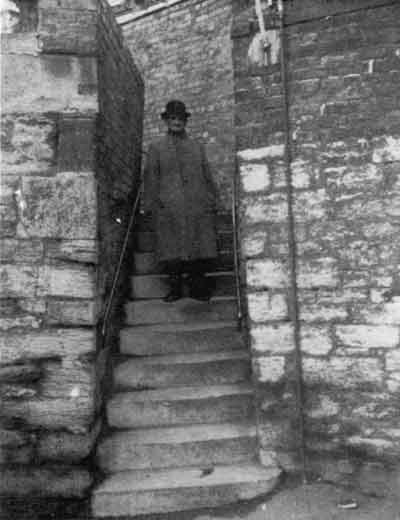 The street pattern of the Conigre is still largely recognisable. The area had been the castle rabbit warren (Conigre is from ‘coney’ and ‘acre’, a rabbit field, the pronunciation kuniger, going back to the time when coney rhymed with money.) There had been some sporadic building in the sixteenth century but the main development was towards the end of the seventeenth century when it was covered with houses for the ‘middling sort’ of people, with one or two bigger houses such as Conigre House which survived into recent years as the Central liberal Club. In the late eighteenth century, the population of Trowbridge increased, leading to a need for more dwellings, and, as the Lord of the Manor would not release any of his demesne, much infilling took place.
The street pattern of the Conigre is still largely recognisable. The area had been the castle rabbit warren (Conigre is from ‘coney’ and ‘acre’, a rabbit field, the pronunciation kuniger, going back to the time when coney rhymed with money.) There had been some sporadic building in the sixteenth century but the main development was towards the end of the seventeenth century when it was covered with houses for the ‘middling sort’ of people, with one or two bigger houses such as Conigre House which survived into recent years as the Central liberal Club. In the late eighteenth century, the population of Trowbridge increased, leading to a need for more dwellings, and, as the Lord of the Manor would not release any of his demesne, much infilling took place.
The Conigre became a densely built over area and, because of the primitive nature of sanitary arrangements, (cesspools and middens) a most insalubrious part of the town. It certainly had a fearsome reputation. Yet, how far was the reputation justified? People lived there, there were shops and a pub, The Harp, and businesses (our bread was baked in one of the Broad Streets). It was largely demolished in 1934 and the rest has disappeared since, Conigre Chapel being demolished in 1988, leaving its schoolrooms as a final vestige. Memories of Doris Elms' childhood in the Conigre was featured in the Spring 2008 newsletter. British Row was named after the Adcroft British School i.e. a school formed under the aegis of the British and Foreign Bible Society, supported mainly by non-conformists and housed in a building, half of which still exists. It was occupied by the Margaret Stancomb Infants' and is planned to be the home of the Wiltshire Rural School of Music.
| Dr Bethanie Afton, Mr H. Bennett, Mr & Mrs N. Dallimore, Mr & Mrs S. Raymond and Mr & Mrs R. Summerson. |
Biss Meadows Country Park - Trowbridge's little known wildlife open space
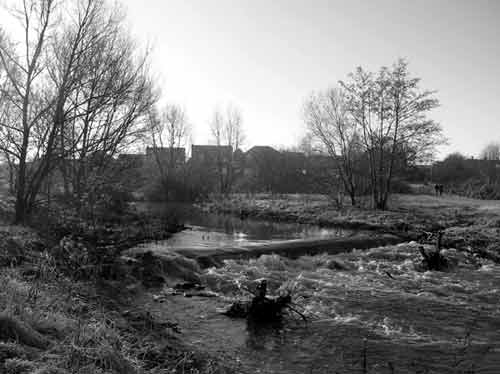
Tucked away between the Tesco superstore,the busy County Way and West Ashton Road, is Biss Meadows Country Park, a pleasant public open space with an exceptional range of wildlife and habitat for an urban location. The Country Park was created in the early 1990s when the previously open fields and River Biss were substantially altered to accommodate Tesco and new housing development. The Country Park has an important role to play as a flood plain to the local houses and the town centre itself, which has a history of damaging floods. Further back in time, the area housed the art-deco town swimming pool and before that a bathing pool in the river itself.(See last issue. Ed) The north east part of Biss Meadows is grassland with asphalt paths and is easily accessible for those in a wheelchair. This area includes a weir and a pond. The south west part is flood plain with scrapes (marsh areas) and needs some care. The scrapes support a variety of aquatic insects that encourages waders, swans and the occasional heron. The southern area is former fields with another pond. In between these areas are a number of meadows that are rich in wild flowers, attracting other insects and birds. Through the site runs the Biss River, a chalk river bringing spring water from Salisbury Plain. Water voles are present and some say they have seen an otter. Birds spotted include reed warbler, reed bunting, sedge warbler, blackcap, coal tit, heron, stonechat, sand martin, swallow and swift. A range of butterflies, dragonflies and damselflies can also be seen in spring and summer.
The Friends of Biss Meadows Country Park was established in late 2008 by a group with a passion to maintain and protect the area and sensitively enhance it for the enjoyment of all. We are applying for grants to enhance and protect the habitat, to provide information and interpretation panels, provide seating and picnic tables, create nature themed art work and to extend the footpaths. We are looking to forge educational links as we feel that Biss Meadows provides a rich habitat to support fieldwork and the curriculum in such areas as ecology, natural sciences and geography. The Friends' comprehensive website http://www.bissmeadows.org.uk provides many photos of the wildlife, a spotters' database, the history of the Biss Meadows and information about the Friends. Membership is free - please see the website. Work parties meet on the second Sunday of each month from 10 am to noon. All skills levels and ages are most welcome. So do come and help to enhance this open space for the well-being of Trowbridge and for the environment.
RECENT MEETINGS |
SOME WILTSHIRE PLACE NAMES by Martyn Whittock Tuesday 19th October 2010
The first of the ‘winter’ meetings was held in the Haden Room of the United Church, with an enthusiastic attendance of about 50, including some very welcome new members.
Martyn Whittock is Head of History at Kingdown School in Warminster and his powerpoint illustrated talk was erudite and entertaining. Interestingly hardly any Roman-Latin names survive in modern English but ‘font’ (well, fountain or spring) may be one as in Urchfont. There are a very few Scandinavian names, eg Haxton, only Devizes from Norman French and nearly all the rest are from Old English (or Anglo Saxon).
Nearly all river names are pre Roman, ie Welsh - our river Biss is derived from the Welsh for twig (tributary). We were told to be wary of ‘ham’ as in Melksham, Corsham etc as although it can mean settlement it is quite likely to be contracted from ‘hamme’ meaning a water meadow area, as in Chippenham. Quidhampton sounds nice but is to do with manure and Hungerdown, indicating impoverished soil, once had an unmentionable name. His favourite is Pomeroy, because of its link with so long ago, recorded in the Bradford on Avon charter of 1001 as plum tree fort. Martin recommended ‘Place names of Wiltshire’ by Gover et al for the serious scholar but his own slimmer book is a good read and dentist Michael Coleman
(corporate member) obligingly keeps a copy in the waiting room. After questions a brief synopsis of the talk and Martyn's book were on sale. His fees and profits are donated to an African charity established by his mother in law.
PUBLIC LECTURE Trowbridge Scrapbooks - Part 2 by Andrew Jones Tuesday 16th November 2010
Some 50 people were present when Andrew took a second dip into his collection of scrapbooks. Winnie Caines, the daughter of a local tailor, compiled the 18 books of cuttings, mainly from the Wiltshire Times, over a period of 50 years until her death in 1984. Some of them cover well known public events, such as the County Hall Fire of 1958; others, like marriage notices and obituaries, are more personal. In this talk Andrew decided to focus on people and buildings. Local benefactors, builders, craftsmen, journalists, shopkeepers, teachers, a newspaper seller and an odd job man were all mentioned. Buildings included the Council Clinic, the Market House and the Parochial School. All drew murmurs of recognition from the audience, many of whom are longstanding residents of the Trowbridge area. But even from the perspective of only two or three years there were still two particular items to interest the diligent member of the Society. (Did you goon the visit to the water treatment works? Did you attend the guided walk of Trowbridge cemetery?)
First the Studley fountain near the Black Horse on Frome Road. This Victorian oddity was constructed as an act of charity by the Revd. W J Hardman of St John's, Upper Studley, in memory of his mother who died in 1860. As the Wiltshire Times put it, ‘he has been at the expense of sinking a public well, which affords a plentiful supply of excellent water for the inhabitants’. All the more significant when you remember that piped water did not become available in Trowbridge until 1874, as we learned at the water treatment works.
We were familiar too with the mausoleum and impressed by it. This fine monument to the Hastings and Kingston families was threatened with demolition until its successful rescue and restoration by the Civic Society in 1981. Not only was the building itself of historical and architectural importance (Grade II listed) but in addition, the Revd. John David Hastings was one of Trowbridge's most outstanding rectors (1841 - 69) and he was responsible for many of the building and restoration projects of the time.
So the Society's restoration has now itself become history and has continued the interaction between people and buildings. Something to encourage us when we feel that our efforts are less effective than they might be.
During the interval we had the opportunity to buy raffle tickets and Society merchandise, including the beautiful new porcelain mugs. Artist Bernard Willington then explained his philosophy in producing his two paintings of Fore Street in 1900. Some of the sales profits of the prints will be donated to the Friends of the Trowbridge Museum.
New Year's Social Tuesday 18th January 2011
It was a very tight squeeze in the Haden Room for the 80 members who attended the New Year's Social and in such a confined space it was impossible not to be ‘social’! Ruth Bridges' hot punch was as delicious as usual and clutching our glasses most of us managed to have a stab at Len Willis's quiz. This year Len had chosen locations in and around Trowbridge to be identified. The level of difficulty was quite high the winner identifying 5 out of 10. The table was groaning with the most delicious food and (in relays) all could pile their plates high.
Glyn then gave us a brief account of some of the records discovered at Lullington Church which he had on display. These painted a vivid picture of the social history of 18th and 19th century village life, including the various medical treatments funded by the parish for the treatment of smallpox, vaccinations, purging and blood letting. The parish paid for clothes for children who were setting out to be apprenticed and also met their apprenticeship fees.
Steve Lovering and Ivor Drinkwater again brought some of their Trowbridge memorabilia - always so fascinating to peruse.
Roger Newman brought the protruding shop sign from A Coke & Son, which was situated at 4 Church Street, and is appealing to members to search for old photos of this shop that he might copy.
Our thanks go to Peter Bull who raised over £70 on the raffle, to Ruth for her punch and Len for the Quiz. Next year we will definitely book the larger room!
| Coleman's Family Dental Practice, Timbrell Street | The Trowbridge Museum |
DOROTHY SAINSBURY
On 10th November 2010 there was a ceremony in Trowbridge Museum to induct Trowbridge-born Dorothy Sainsbury on to the Trowbridge First World War Roll of Honour. Dorothy Sainsbury was related to the Sainsbury family who owned the grocery and animal feed stores. Trained as a nurse, in 1914 she went to France and in 1915 she joined the French Flag Nursing Corps. She was subsequently awarded the French decoration, the CROIX DE GUERRE for ‘unlimited devotion towards the sick and wounded. In difficult and particularly perilous circumstances, under bombardments has given proof of courage and coolness.’ She continued her humanitarian work after the War in the devastated areas of northern France and was also awarded the MEDAILLE DE LA RECONNAISSANCE FRANCAISE.
(This event was a nice coincidence with our last edition carrying Patience Morris's piece on the other branch of the Sainsbury family. Eds)
THOMAS HENRY WYATT 1807 - 1880 Architect
Born in Ireland, based in London, for a while in partnership with David Brandon, he was a consultant to Salisbury Diocese, the Lunacy Commission and several other bodies. He was involved in building, rebuilding and restoring well over 50 churches in Wiltshire including those at West Ashton, Westbury, Hilperton and North Bradley (all between1846-1862). He designed the Rectory at Broughton Gifford (1848), Orchardleigh Estate (1856, Elizabethan according to Pevsner but ‘chateau-esque’ to me), Devizes Assizes (1835 - Grecian, most of the rest were Gothic in style), Roundway Hospital (1851 - now converted to apartments and very nice too) and Cranmore Tower (1862-64). The Italian job (St Mary and St Nicholas 1841-5) at Wilton is well worth a look. Thomas Henry was just one of a dynasty of Wyatt architects. His cousins Samuel and Lewis William (uncle and nephew) designed and rebuilt Tatton Park, the famous National Trust managed property in Cheshire.
The United Church
The Church began at the time of protestant dissention in the C18 propagated by John and Charles Wesley and George Whitefield. They had trained together at Oxford to become Anglican priests in the 1730s and were strongly influenced by non-conformist ideas coming in from the continent. The Wesleys favoured the Arminian way of worship while Whitefield followed the Calvinists. In 1739 Whitefield came to the Bristol area but was banned from Anglican churches because of his ideas. However he took to open air preaching and found the coalminers of outlying Kingswood eager to listen as did many more who had heard about him. In Trowbridge a Joanna Cook was born in 1731 and baptised into the Anglican Church a year later. By 1760 she had heard about Whitefield's preaching and joined a local society of dissenters. They moved from house to house between Hilperton and Trowbridge to avoid harassment by supporters of the established church. Becoming increasingly serious she invited John Wesley to preach in Trowbridge although she favoured Whitefield's Calvinist teachings. In 1764 she introduced her 19 year old cousin John Clark into protestant dissention. Finding him a good speaker the local group invited him to read the published sermons at its meetings in Hilperton. In 1766 Joanna married Thomas Turner, a grocer, after completion of their house over the shop at the lower end of the Parade. The house included a large room for meetings of the dissenters. Unfortunately it was almost immediately seriously damaged by an explosion in the shop where gun powder was stored. The dissenters returned to Hilperton for their meetings and the Turners to a cottage Joanna owned in the town. In 1767 the society of dissenters legally ‘Settled the Order of a Church’ under the names of Sarah and Mary Webb, Sarah and Stephen Slade, William Ferris and John Coggeswell. The Turners were not apparently signatories to this new church. Sarah Webb ‘set apart her house for religious use for the body of Protestant Dissenters under the character of Independants’. John Clark was pastor and there they celebrated Holy Communion amongst themselves.
Thomas and Joanna however were determined that the newly ordered church should occupy purpose-built premises and set about fund raising. Thomas on his business visits to Bristol raised funds there that were sufficient to begin building. By November 1771 their new church on the present site off the then Back Street in Trowbridge opened measuring 30 x 40 feet. The name Tabernacle was adopted as John Clark stated ‘We approve of the sentiments of Mr Whitefield’. The sentiments being those of the Calvinists who referred to their prayer meeting houses as Tabernacles - defined in Exodus Chapter 26 as a moveable building or an elaborate type of tent. The new church was described as ‘supported by two columns (to become known as Jackin and Boaz)’. This implied that two columns were set in the centre of the rectangular floor space to divide the roof-span of 30 feet in half for economy's sake. The building was probably of domestic (small) scale built of rubble stone with a hipped slate roof.
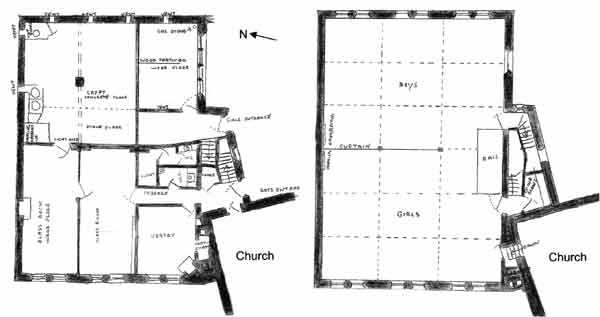 | |
| Ground Floor | First Floor |
| The 1842 Sunday School building. Original Sketch Plans | |
| The building was erected on the site of the C18 burial ground and at least 4 graves lie beneath it hence the term ‘crypt’ for areas of the ground floor. These have become a kitchen, store and boiler room with a corridor to the 1882 classroom extension. Several further graves in a vault were found beneath the Office on renewal of the floor in 1937 when its window was also altered. The first floor is largely unchanged except for the loss of one of the three windows where the extension is attached. Today the building has a single entrance and a single stairs. | |
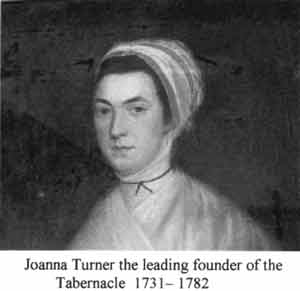 In April 1774 John Clark aged 29 attended Devizes Sessions to become the first licensed pastor of the Tabernacle and styled the Revd. John Clark. In 1784 Joseph Shaw and William Collier supervised a Sunday School in Back Lane where their school had outgrown the building. They hired room at the Tabernacle and by the following year a gallery had been provided for them to seat 250 pupils and teachers. That year Joanna Turner died of breast cancer aged only 52. In 1794 the Tabernacle building was doubled in size to 60 x 40 feet. In 1808 the Revd. John Clark retired and was succeeded by Revd. John Innis. Between 1814 and 1827 more rooms were added to accommodate the expanding Sunday School. By 1835 there were 155 males with 52 teachers and 181 females with 60 teachers. The Tabernacle was rebuilt above pew level with galleries built along the side walls to seat the 450 in the Sunday School. Many of the attendees were illiterate factory workers and their children. Few if any attended a school on weekdays. Males and females were strictly segregated into separate classrooms and parts of the Assembly Room as can be seen on the plans of the Sunday School building erected in 1842. There were even separate entrances and staircases. This building although altered is still part of the group today. It accommodated classrooms, lavatories, a vestry and a first floor Assembly Room now divided by a folding screen. It has rubble stone walls, Bath stone quoins and cast iron two storey high lancet windows all covered by a hipped slate roof. A Mr Joseph Slade contributed generously to the cost.
In April 1774 John Clark aged 29 attended Devizes Sessions to become the first licensed pastor of the Tabernacle and styled the Revd. John Clark. In 1784 Joseph Shaw and William Collier supervised a Sunday School in Back Lane where their school had outgrown the building. They hired room at the Tabernacle and by the following year a gallery had been provided for them to seat 250 pupils and teachers. That year Joanna Turner died of breast cancer aged only 52. In 1794 the Tabernacle building was doubled in size to 60 x 40 feet. In 1808 the Revd. John Clark retired and was succeeded by Revd. John Innis. Between 1814 and 1827 more rooms were added to accommodate the expanding Sunday School. By 1835 there were 155 males with 52 teachers and 181 females with 60 teachers. The Tabernacle was rebuilt above pew level with galleries built along the side walls to seat the 450 in the Sunday School. Many of the attendees were illiterate factory workers and their children. Few if any attended a school on weekdays. Males and females were strictly segregated into separate classrooms and parts of the Assembly Room as can be seen on the plans of the Sunday School building erected in 1842. There were even separate entrances and staircases. This building although altered is still part of the group today. It accommodated classrooms, lavatories, a vestry and a first floor Assembly Room now divided by a folding screen. It has rubble stone walls, Bath stone quoins and cast iron two storey high lancet windows all covered by a hipped slate roof. A Mr Joseph Slade contributed generously to the cost.
In 1841 the Tabernacle was licensed to solemnize marriages and the first wedding that year was of George Nelson Haden to Mary Poynton. They went on to live at Homefield House. Originally the church buildings could only be reached from the street by a foot passage under No. 24. In 1871 the adjacent house now known as Fernleigh House and its grounds were purchased at auction with a view to improving access to the Tabernacle from Church Street. Across the grounds a vehicular drive was made up to the church doors. Also a mediaeval style Bath stone arch with wrought iron gates was built between the house and No.25 on the frontage. To each side were gateways for pedestrians. The architect was William Stent of Warminster and the gates made by Messrs Tucker and Hobbs. Fernleigh House known then as Tabernacle House was then leased to the Cottage Hospital Committee. The hospital moved to its own purpose-built premises in the Halve in 1886. Fernleigh House was leased to and subsequently sold to Usher's Brewery in 1953. In 1882 on land presented by Mr Haden classrooms were built on to the 1842 Sunday School in a style described as Jacobean collegiate revival. These exist today as a refectory, known as the Sainsbury Room, and kitchen above a row of small office and ancillary rooms.
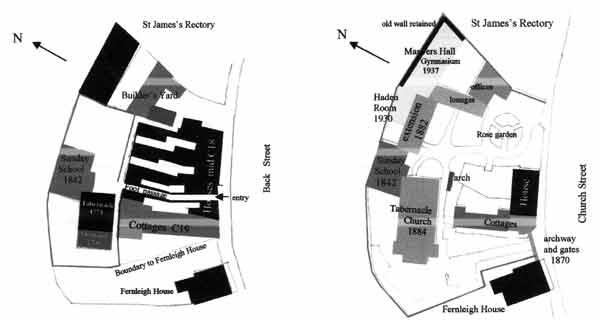 | |
| Tabernacle Church early development 1771 - 1869 Earliest buildings in dark tone. Latest in light tone | Tabernacle Church later development and demolitions Comparative layout plan 1870 - 1990 |
During the same year under the Revd. Thomas Mann (minister 1839 - 1894) it was decided that the church was again too small and plans were made to build it completely anew to a much larger scale in perpendicular style complete with a tower 80 feet high. The architects were Paull and Bonella of Bath and the builder William Smith of Trowbridge. Seats were provided for 715. The foundation stone was laid by J Kemp Welch JP. The new church measured 89 x 40 feet and was attached to the 1842 building by the same connecting doorways as before. This siting required the demolition of one cottage from the end of the rank on the south side.
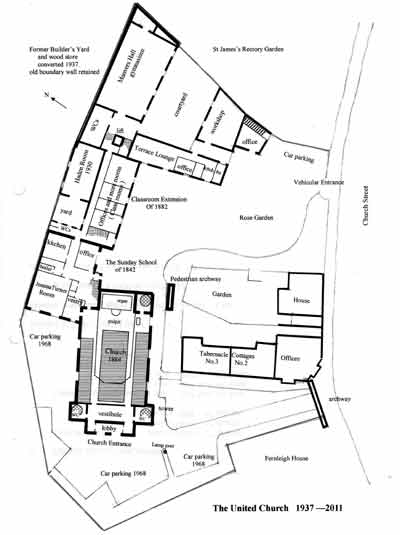 The Deacons invited one of their number George Nelson Haden to design the heating and ventilation installation. Many of the windows included stained glass contributed by church members. Several were eminent in Trowbridge and are still familiar names today: Isaac Chapman, John and Catherine Clark, Thomas Drinkwater, George Haden, Joseph Houlton, Edward Little, William Offer, John Perkins Stancomb, Joseph Slade, William Smith (the builder), Thomas and Joanna Turner and Thomas Usher. Later memorials and tablets on the walls include those to: Edward Bacon Evans, George Nelson Haden, William Nelson Haden, Charles Ingham Haden,
Revd. Thomas Mann, Richard and Henry Sainsbury and William Roger Brown. (And in 1968 tablets transferred from Manvers Street Methodist Church include: Abraham and Elijah Bowyer and Ephraim Usher.) On completion in 1884 the deeds of the church property were handed over to the Wilts and East Somerset Congregational Union. Burials around the church were discontinued. With finance from its affluent members the buildings and grounds increased and developed to nearly an acre. In 1898 the builder's yard of the late William Smith adjoining was taken into church ownership and a shop and a house fronting Church Street were also acquired. Most of the domestic buildings in the back-land were demolished to improve on congestion at the rear of the street frontage house and cottages.
The Deacons invited one of their number George Nelson Haden to design the heating and ventilation installation. Many of the windows included stained glass contributed by church members. Several were eminent in Trowbridge and are still familiar names today: Isaac Chapman, John and Catherine Clark, Thomas Drinkwater, George Haden, Joseph Houlton, Edward Little, William Offer, John Perkins Stancomb, Joseph Slade, William Smith (the builder), Thomas and Joanna Turner and Thomas Usher. Later memorials and tablets on the walls include those to: Edward Bacon Evans, George Nelson Haden, William Nelson Haden, Charles Ingham Haden,
Revd. Thomas Mann, Richard and Henry Sainsbury and William Roger Brown. (And in 1968 tablets transferred from Manvers Street Methodist Church include: Abraham and Elijah Bowyer and Ephraim Usher.) On completion in 1884 the deeds of the church property were handed over to the Wilts and East Somerset Congregational Union. Burials around the church were discontinued. With finance from its affluent members the buildings and grounds increased and developed to nearly an acre. In 1898 the builder's yard of the late William Smith adjoining was taken into church ownership and a shop and a house fronting Church Street were also acquired. Most of the domestic buildings in the back-land were demolished to improve on congestion at the rear of the street frontage house and cottages.
Electricity was connected to the church in 1922 for lighting and a mechanical blower to replace the manual blowers for the organ. In 1928 the Church Meeting resolved to transfer the church property to the Congregational Union of England and Wales. William Nelson Haden died in 1930 and the Haden Room was built in his and his wife's memory as a ladies' meeting room. On the closure of Silver Street Presbyterian chapel artefacts were reassigned by the charity commissioners to several churches in the area. A George III silver baptismal bowl was received by the Tabernacle. In 1935 an evening service was broadcast from the church by BBC Radio West region. In 1937 the shop on Church Street was demolished to open up the frontage to form a rose garden with new entrance gates and piers built. The Deacons' vestry in the 1842 building was renovated with a new floor and a new window to match those of the 1882 extension. A vault found beneath contained several bodies and a headstone dated 1785. These were carefully re-interred. The buildings of William Smith's builder's yard were converted to meeting rooms, kitchen and a gymnasium (previously the builder's timber store) all generously funded by Charles Ingham Haden. During World War II these and other ancillary church rooms were used as a school for 250 evacuee children. In 1952 the choir moved from its elevated position behind the pulpit to side facing pews level with the congregation. In March 1961 the church was renovated including the roof and organ for £2300. Two rows of pews were removed from the rear. A morning service was broadcast by BBC Radio. In June and September some members of the church appeared on television led by the Revd. Noel Calvin. The church roll at the time was 156.
In 1967 Manvers Street Methodist Church became unfit for use and its congregation joined the Congregationalists at Tabernacle. In September 1968 the title of Tabernacle was dropped and the church became the United. During 1968 an agreement was reached with the County Council to hire under licence much of the premises for the West Wiltshire Community Care Centre. This required that most of the buildings be extensively renovated and some altered to accommodate the young mentally disabled and the elderly in day-care. Classrooms, workshops, lounges, kitchens, a large hall and a canteen were provided. Car parking space was made for staff over part of the former burial ground and turning space for taxis and minibuses around the rose garden. Two of the cottages were let to church members on an informal basis and No.24 on Church Street was occupied by a caretaker/administrator. The corner house adjoining the archway was let as offices. When the Wilts and East Somerset Congregational Union became the United Reform Church the church and buildings became the property of the South Western Synod of the United Reform Church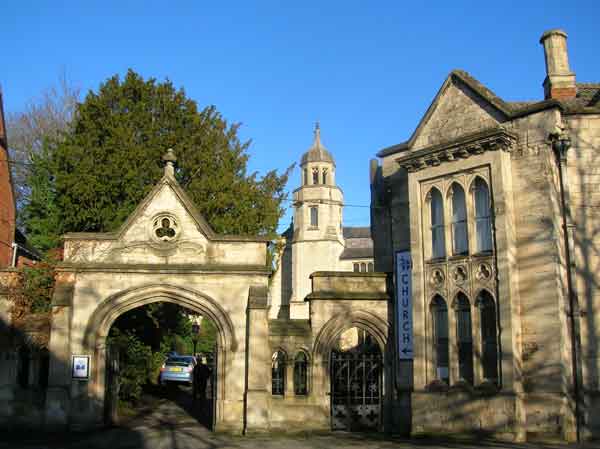 at Taunton. Since the alterations of 1968 the church has been altered little save for new lighting, a lobby screen and improved disabled access to the interior in 1991 and 1996. The County Council backed Community Care Centre closed to young persons' groups in 2000 and to elderly day-care in 2007. Many of the ancillary buildings are now used as offices by counselling services and as meeting rooms for training and voluntary groups and societies, AA, weight watchers, dancers, yoga, bridge, etc., not forgetting the Civic Society. Three church groups including United use various rooms and the church on Sundays. In addition the church is increasingly used for concerts because of its seating for more than 600, its good acoustics and ancillary facilities.
at Taunton. Since the alterations of 1968 the church has been altered little save for new lighting, a lobby screen and improved disabled access to the interior in 1991 and 1996. The County Council backed Community Care Centre closed to young persons' groups in 2000 and to elderly day-care in 2007. Many of the ancillary buildings are now used as offices by counselling services and as meeting rooms for training and voluntary groups and societies, AA, weight watchers, dancers, yoga, bridge, etc., not forgetting the Civic Society. Three church groups including United use various rooms and the church on Sundays. In addition the church is increasingly used for concerts because of its seating for more than 600, its good acoustics and ancillary facilities.
The legacy of such a large group of buildings, although an asset in many ways, is becoming increasingly onerous for the ageing congregation to support and maintain. The future for the whole group is uncertain. It however continues to be a remarkable and unusual complex which assembled by devout and eminent Trowbridge people should not now be allowed to disintegrate.
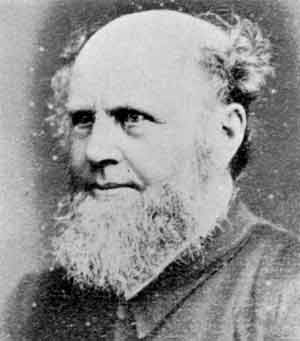 | 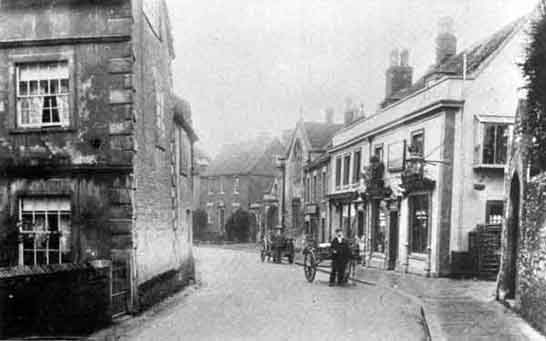 |
| Revd Thomas Mann, minister for 55 years | Church Street before the widenings of the 1930s and 1950s |
